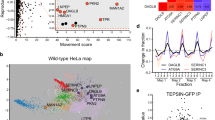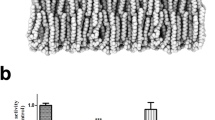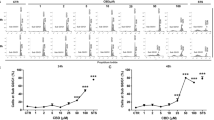Abstract
The endocannabinoid anandamide is removed from the synaptic space by a selective transport system, expressed in neurons and astrocytes, that remains molecularly uncharacterized. Here we describe a partly cytosolic variant of the intracellular anandamide-degrading enzyme fatty acid amide hydrolase-1 (FAAH-1), termed FAAH-like anandamide transporter (FLAT), that lacked amidase activity but bound anandamide with low micromolar affinity and facilitated its translocation into cells. Known anandamide transport inhibitors, such as AM404 and OMDM-1, blocked these effects. We also identified a competitive antagonist of the interaction of anandamide with FLAT, the phthalazine derivative ARN272, that prevented anandamide internalization in vitro, interrupted anandamide deactivation in vivo and exerted profound analgesic effects in rodent models of nociceptive and inflammatory pain, which were mediated by CB1 cannabinoid receptors. The results identify FLAT as a critical molecular component of anandamide transport in neural cells and a potential target for therapeutic drugs.
This is a preview of subscription content, access via your institution
Access options
Subscribe to this journal
Receive 12 print issues and online access
$209.00 per year
only $17.42 per issue
Buy this article
- Purchase on Springer Link
- Instant access to full article PDF
Prices may be subject to local taxes which are calculated during checkout




Similar content being viewed by others
Change history
15 December 2011
In the version of this article initially published, ref. 36 (given as Kaczowka, S.J. et al. Int. J. Biol. Macromol. 42, 62–67, 2008) was incorrect. The correct reference is Kaczocha, M., Glaser, S.T. & Deutsch, D.G. Identification of intracellular carriers for the endocannabinoid anandamide. Proc. Natl. Acad. Sci. USA 106, 6375–6380 (2009). The error has been corrected in the HTML and PDF versions of the article.
References
Piomelli, D., Astarita, G. & Rapaka, R. A neuroscientist's guide to lipidomics. Nat. Rev. Neurosci. 8, 743–754 (2007).
Devane, W.A. et al. Isolation and structure of a brain constituent that binds to the cannabinoid receptor. Science 258, 1946–1949 (1992).
Beltramo, M. et al. Functional role of high-affinity anandamide transport, as revealed by selective inhibition. Science 277, 1094–1097 (1997).
Hillard, C.J., Edgemond, W.S., Jarrahian, A. & Campbell, W.B. Accumulation of N-arachidonoylethanolamine (anandamide) into cerebellar granule cells occurs via facilitated diffusion. J. Neurochem. 69, 631–638 (1997).
Hillard, C.J., Shi, L., Tuniki, V.R., Falck, J.R. & Campbell, W.B. Studies of anandamide accumulation inhibitors in cerebellar granule neurons: comparison to inhibition of fatty acid amide hydrolase. J. Mol. Neurosci. 33, 18–24 (2007).
Cravatt, B.F. et al. Supersensitivity to anandamide and enhanced endogenous cannabinoid signaling in mice lacking fatty acid amide hydrolase. Proc. Natl. Acad. Sci. USA 98, 9371–9376 (2001).
McKinney, M.K. & Cravatt, B.F. Structure and function of fatty acid amide hydrolase. Annu. Rev. Biochem. 74, 411–432 (2005).
Wei, B.Q., Mikkelsen, T.S., McKinney, M.K., Lander, E.S. & Cravatt, B.F. A second fatty acid amide hydrolase with variable distribution among placental mammals. J. Biol. Chem. 281, 36569–36578 (2006).
Hillard, C.J. & Jarrahian, A. Cellular accumulation of anandamide: consensus and controversy. Br. J. Pharmacol. 140, 802–808 (2003).
Di Marzo, V. Targeting the endocannabinoid system: to enhance or reduce? Nat. Rev. Drug Discov. 7, 438–455 (2008).
Piomelli, D. et al. Structural determinants for recognition and translocation by the anandamide transporter. Proc. Natl. Acad. Sci. USA 96, 5802–5807 (1999).
Glaser, S.T. et al. Evidence against the presence of an anandamide transporter. Proc. Natl. Acad. Sci. USA 100, 4269–4274 (2003).
Jacobsson, S.O. & Fowler, C.J. Characterization of palmitoylethanolamide transport in mouse Neuro-2a neuroblastoma and rat RBL-2H3 basophilic leukaemia cells: comparison with anandamide. Br. J. Pharmacol. 132, 1743–1754 (2001).
Matlin, A.J., Clark, F. & Smith, C.W. Understanding alternative splicing: towards a cellular code. Nat. Rev. Mol. Cell Biol. 6, 386–398 (2005).
Bracey, M.H., Hanson, M.A., Masuda, K.R., Stevens, R.C. & Cravatt, B.F. Structural adaptations in a membrane enzyme that terminates endocannabinoid signaling. Science 298, 1793–1796 (2002).
Patricelli, M.P. & Cravatt, B.F. Fatty acid amide hydrolase competitively degrades bioactive amides and esters through a nonconventional catalytic mechanism. Biochemistry 38, 14125–14130 (1999).
Ortar, G., Ligresti, A., De Petrocellis, L., Morera, E. & Di Marzo, V. Novel selective and metabolically stable inhibitors of anandamide cellular uptake. Biochem. Pharmacol. 65, 1473–1481 (2003).
Alexander, J.P. & Cravatt, B.F. Mechanism of carbamate inactivation of FAAH: implications for the design of covalent inhibitors and in vivo functional probes for enzymes. Chem. Biol. 12, 1179–1187 (2005).
Speers, A.E. & Wu, C.C. Proteomics of integral membrane proteins–theory and application. Chem. Rev. 107, 3687–3714 (2007).
Ortega-Gutiérrez, S., Hawkins, E.G., Viso, A., Lopez-Rodriguez, M.L. & Cravatt, B.F. Comparison of anandamide transport in FAAH wild-type and knockout neurons: evidence for contributions by both FAAH and the CB1 receptor to anandamide uptake. Biochemistry 43, 8184–8190 (2004).
Kathuria, S. et al. Modulation of anxiety through blockade of anandamide hydrolysis. Nat. Med. 9, 76–81 (2003).
Yates, M.L. & Barker, E.L. Inactivation and biotransformation of the endogenous cannabinoids anandamide and 2-arachidonoylglycerol. Mol. Pharmacol. 76, 11–17 (2009).
Ligresti, A. et al. Further evidence for the existence of a specific process for the membrane transport of anandamide. Biochem. J. 380, 265–272 (2004).
La Rana, G. et al. Modulation of neuropathic and inflammatory pain by the endocannabinoid transport inhibitor AM404 [N-(4-hydroxyphenyl)-eicosa-5,8,11,14-tetraenamide]. J. Pharmacol. Exp. Ther. 317, 1365–1371 (2006).
Maione, S. et al. Antinociceptive effects of tetrazole inhibitors of endocannabinoid inactivation: cannabinoid and non-cannabinoid receptor-mediated mechanisms. Br. J. Pharmacol. 155, 775–782 (2008).
Lichtman, A.H. et al. Reversible inhibitors of fatty acid amide hydrolase that promote analgesia: evidence for an unprecedented combination of potency and selectivity. J. Pharmacol. Exp. Ther. 311, 441–448 (2004).
Russo, R. et al. The fatty acid amide hydrolase inhibitor URB597 (cyclohexylcarbamic acid 3′-carbamoylbiphenyl-3-yl ester) reduces neuropathic pain after oral administration in mice. J. Pharmacol. Exp. Ther. 322, 236–242 (2007).
Beltramo, M. & Piomelli, D. Carrier-mediated transport and enzymatic hydrolysis of the endogenous cannabinoid 2-arachidonylglycerol. Neuroreport 11, 1231–1235 (2000).
Bisogno, T. et al. The uptake by cells of 2-arachidonoylglycerol, an endogenous agonist of cannabinoid receptors. Eur. J. Biochem. 268, 1982–1989 (2001).
Niot, I., Poirier, H., Tran, T.T. & Besnard, P. Intestinal absorption of long-chain fatty acids: evidence and uncertainties. Prog. Lipid Res. 48, 101–115 (2009).
Kanai, N. et al. Identification and characterization of a prostaglandin transporter. Science 268, 866–869 (1995).
Reese-Wagoner, A., Thompson, J. & Banaszak, L. Structural properties of the adipocyte lipid binding protein. Biochim. Biophys. Acta 1441, 106–116 (1999).
Schwartz, G.J. et al. The lipid messenger OEA links dietary fat intake to satiety. Cell Metab. 8, 281–288 (2008).
Gulyas, A.I. et al. Segregation of two endocannabinoid-hydrolyzing enzymes into pre- and postsynaptic compartments in the rat hippocampus, cerebellum and amygdala. Eur. J. Neurosci. 20, 441–458 (2004).
Bojesen, I.N. & Hansen, H.S. Binding of anandamide to bovine serum albumin. J. Lipid Res. 44, 1790–1794 (2003).
Kaczocha, M., Glaser, S.JT. & Deutsch, D.G. . Identification of intracellular carriers for the endocannabinoid anandamide. Proc. Natl. Acad. Sci. USA 106, 6375–6380 (2009).
Maccarrone, M., Dainese, E. & Oddi, S. Intracellular trafficking of anandamide: new concepts for signaling. Trends Biochem. Sci. 35, 601–608 (2010).
Oddi, S. et al. Molecular identification of albumin and Hsp70 as cytosolic anandamide-binding proteins. Chem. Biol. 16, 624–632 (2009).
Rosso, L. & Gould, I.R. Structure and dynamics of phospholipid bilayers using recently developed general all-atom force fields. J. Comput. Chem. 29, 24–37 (2008).
Abagyan, R. & Totrov, M. Biased probability Monte Carlo conformational searches and electrostatic calculations for peptides and proteins. J. Mol. Biol. 235, 983–1002 (1994).
Phillips, J.C. et al. Scalable molecular dynamics with NAMD. J. Comput. Chem. 26, 1781–1802 (2005).
Hornak, V. et al. Comparison of multiple Amber force fields and development of improved protein backbone parameters. Proteins 65, 712–725 (2006).
Rocchia, W., Alexov, E. & Honig, B. Extending the applicability of the nonlinear Poisson–Boltzmann equation: multiple dielectric constants and multivalent ions. J. Phys. Chem. B 105, 6507–6514 (2001); addition/correction 105, 6754 (2001).
Seierstad, M. & Breitenbucher, J.G. Discovery and development of fatty acid amide hydrolase (FAAH) inhibitors. J. Med. Chem. 51, 7327–7343 (2008).
Evans, M.S., Collings, M.A. & Brewer, G.J. Electrophysiology of embryonic, adult and aged rat hippocampal neurons in serum-free culture. J. Neurosci. Methods 79, 37–46 (1998).
Pearson, G.D. & Mekalanos, J.J. Molecular cloning of Vibrio cholerae enterotoxin genes in Escherichia coli K-12. Proc. Natl. Acad. Sci. USA 79, 2976–2980 (1982).
Fu, J. et al. Food intake regulates oleoylethanolamide formation and degradation in the proximal small intestine. J. Biol. Chem. 282, 1518–1528 (2007).
Li, X. et al. Expression genetics identifies spinal mechanisms supporting formalin late phase behaviors. Mol. Pain 6, 11 (2010).
Hargreaves, K., Dubner, R., Brown, F., Flores, C. & Joris, J. A new and sensitive method for measuring thermal nociception in cutaneous hyperalgesia. Pain 32, 77–88 (1988).
Acknowledgements
We thank G. Colombano, J. Kim, S. Mandrup-Bertozzi, D. Thongkham, G. Moreno-Sanz and R. Scarpelli for help with experiments and discussions about the project. This research was supported by grants from the US National Institute on Drug Abuse and the US National Institute on Alcohol Abuse and Alcoholism (DA-012413 to D.P.) and the US National Institute on General Medicine (1R01GM093937-01 to W.R.). The support provided by the Agilent/University of California Irvine Analytical Discovery Facility is gratefully acknowledged.
Author information
Authors and Affiliations
Contributions
J.F. conducted the molecular biological, biochemical and pharmacological experiments in vitro and analyzed data. G.B. conducted the virtual ligand screening campaign. G.B., W.R., M. Masetti, A.L. and A.C. performed the computational studies. T.B. provided chemical expertise. O.S., R.B. and A.R. conducted the pharmacological experiments in vivo and analyzed data. A.G. measured lipid levels in vivo and analyzed data. A.A. and G.G. conducted analytical studies on purified recombinant FLAT. D.P. conceived and designed the experiments, oversaw the project and wrote the manuscript with assistance from J.F., G.B., W.R., M. Mor, A.L. and A.C.
Corresponding author
Ethics declarations
Competing interests
A patent was filed by the University of California, Irvine, and the Italian Institute of Technology on behalf of D.P., J.F., G.B. and A.C.
Supplementary information
Supplementary Text and Figures
Supplementary Figures 1–15, Supplementary Table 1 (PDF 1270 kb)
Rights and permissions
About this article
Cite this article
Fu, J., Bottegoni, G., Sasso, O. et al. A catalytically silent FAAH-1 variant drives anandamide transport in neurons. Nat Neurosci 15, 64–69 (2012). https://doi.org/10.1038/nn.2986
Received:
Accepted:
Published:
Issue Date:
DOI: https://doi.org/10.1038/nn.2986
This article is cited by
-
The Role of the Endocannabinoid System and Genetic Variation in Adolescent Brain Development
Neuropsychopharmacology (2018)
-
Neurobiological Interactions Between Stress and the Endocannabinoid System
Neuropsychopharmacology (2016)
-
Self-administration of the anandamide transport inhibitor AM404 by squirrel monkeys
Psychopharmacology (2016)



